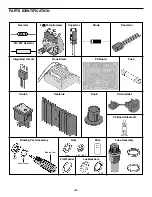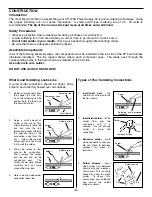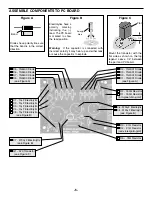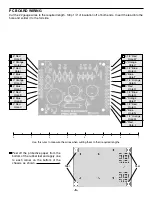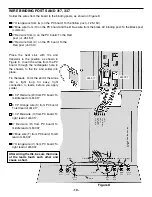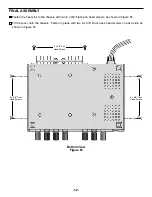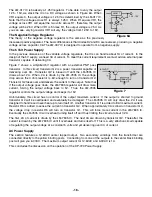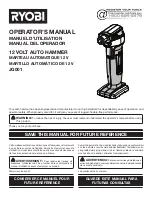
-9-
Slip the 1/2” diameter shrink tubing over the 6” 20 ga. red wire and the smooth or round line cord wire. Solder
the line cord wire to the end lug on the fuse holder, as shown in Figure I. Solder the 6” 20 ga. red wire to the
side lug on the fuse holder. Slide the shrink tubing over the fuse holder, covering the two lugs.
Shrink the 1/2” and 3/4” tubings in place using a hair dryer, heat gun (at lowest setting or you will melt the
tubing), or the heat emitting from your soldering iron.
Solder the two red transformer wires to the holes marked T2 on the PC board.
Solder the black transformer wire to the hole marked CT1 on the PC board.
Solder the two blue transformer wires to the holes marked T1 on the PC board.
Solder the two yellow transformer wires to the yellow AC output binding posts.
Cut a 6” blue wire and strip 1/4” of insulation off of both ends. Solder one end of the 6” blue wire and the blue
wire from point “D” to the black binding post.
Push the PC board stand-offs in the four holes in the bottom of the chassis (see Figure J). Push the PC board
down in place.
WIRING LINE CORD, FUSE, TRANSFORMER AND SWITCH
Figure I
Install the line cord ground lug to the chassis
using a 6-32 x 3/8” screw and a 6-32 large
nut in the location shown in Figure I.
Strip the insulation off of both ends of the
6” red 20 ga. wire to expose 1/4” of bare
wire. Solder one end of the wire to lug 3 on
the rocker switch, as shown in Figure I.
Slip the other end of the 6” strip of red wire
(from lug 3), the (A) and (B) black
transformer wire, and the ribbed line cord
wire through the 3/4” diameter piece of
shrink tubing (as shown in Figure I).
CAUTION: DO NOT
touch any wires or
tubing with the iron.
Solder the black transformer wire (B), as
shown in Figure I to lug 2 on the rocker
switch.
Twist the black transformer wire (A) and
the ribbed or flat line cord wire together.
Solder the two wires to lug 1 on the rocker
switch, as shown in Figure I.
Slide the 3/4” diameter shrink tubing over
the switch.
PC Board
Chassis
Figure J
Side Lug
End Lug
Smooth Line Cord
Flat or Ribbed Line Cord
1 2
3
(A) Black
Red
Red
1/2” Tubing
Yellow
Yellow
Yellow
Yellow
6” Blue
“D” Blue
AC Binding Posts
Ribbed
Line Cord
Blue
Black
Blue
(B) Black
J
K
T2
T2
T1
CT1
T1
W
V
U
6-32
Large Nut
3/4” Shrink
Tubing
6” 20 Ga.
Red
6-32 x 3/8”
Screw



